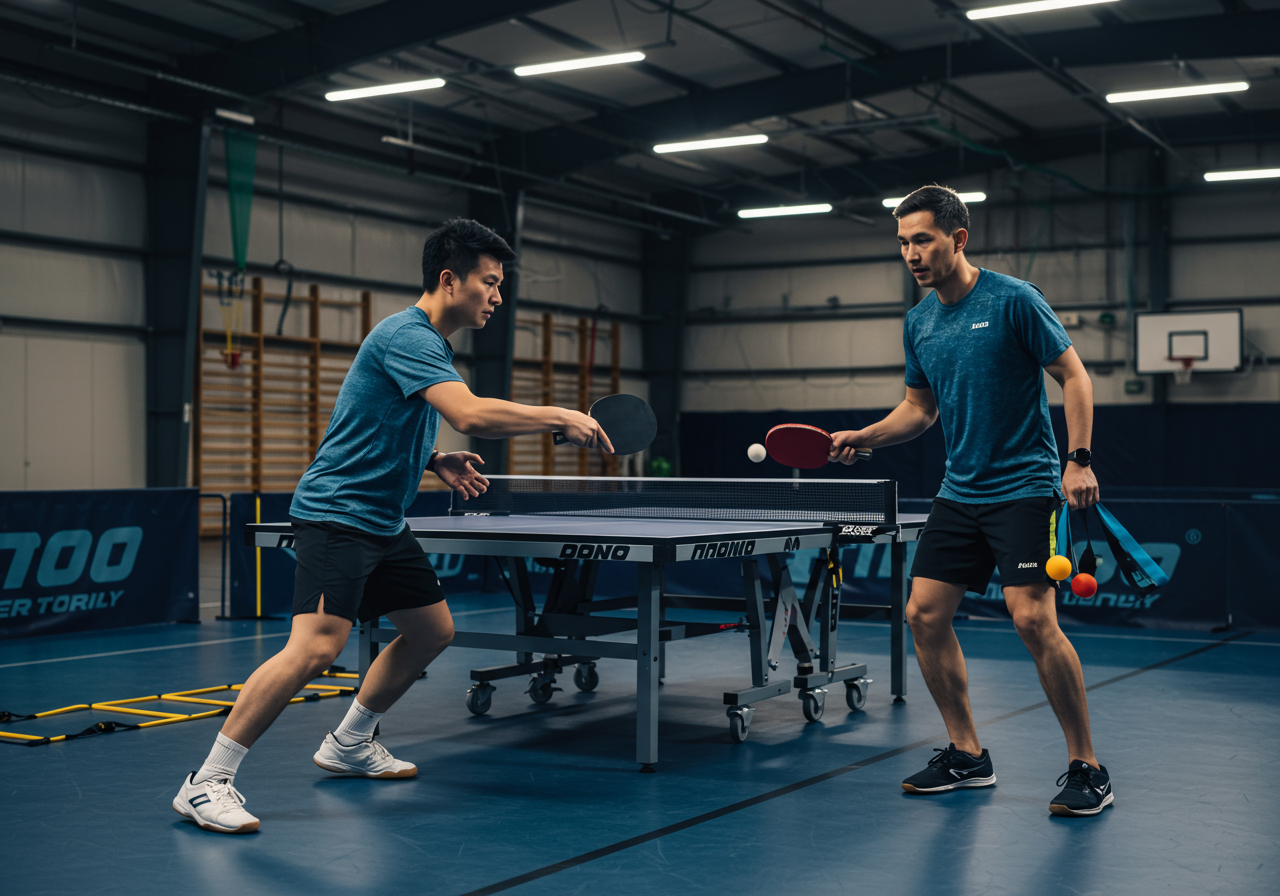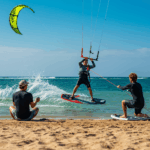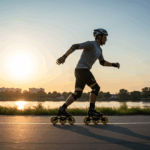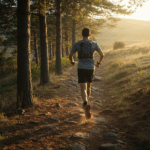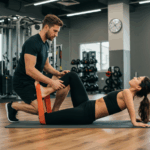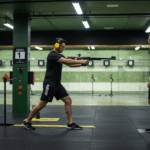The Blueprint: Table Tennis Training That Shapes Mind and Body

The blueprint connects skills, cardio, strength, and mobility
This system builds sharper focus and faster reflexes. It also improves endurance, strength, and joint health.
I schedule skill before heavy lifting. Fast skills need a fresh nervous system.
I track heart rate with a Garmin watch. I record food with MyFitnessPal.
- Skill-first sequencing: do on-table drills before strength.
- Two energy targets: Zone 2 base and short Zone 4–5 bursts.
- Strength essentials: legs, core anti-rotation, shoulders, and grip.
- Mobility priority: ankles, hips, thoracic spine, wrists.
- Visual-cognitive work: saccades, tracking, and reaction drills.
| Day | Focus | Session Details |
|---|---|---|
| Mon | Skills + Strength | Table 45 min (Z2–Z3), Lower-body strength 35 min, Mobility 10 min |
| Tue | Aerobic Base | Bike or brisk walk 35–45 min at Zone 2 |
| Wed | Skills + Speed | Table 40 min with sprints, Agility ladder 10 min |
| Thu | Strength + Mobility | Upper-body strength 30 min, Core 10 min, Mobility 15 min |
| Fri | Skills + Intervals | Table 50 min, 6–10 rounds 20s fast/40s easy |
| Sat | Active Recovery | Walk 30 min, Stretch 15 min, Breath work 5 min |
| Sun | Match Play | Friendly matches 60–90 min, Easy cooldown 10 min |
Heart rate zones guide intensity. They protect beginners from overdoing it.
| Zone | % HRmax | Use in plan |
|---|---|---|
| Z2 | 60–70% | Base work and long rallies |
| Z3 | 70–80% | Sustained drills |
| Z4 | 80–90% | High-speed footwork |
| Z5 | 90–95% | Short finishing bursts |
- Jump rope 2 min at Z2.
- World’s greatest stretch 2 min.
- Band pull-aparts 30 reps.
- Wrist circles 30 sec each way.
- Ladder in-in-out 2 min.
- Two shadow rallies 60 sec.
Strength lifts target court performance. They keep joints stable under speed.
| Lift | Sets x Reps | Rest | Note |
|---|---|---|---|
| Goblet squat | 3 x 8–10 | 90 sec | Drive from mid-foot |
| Romanian deadlift | 3 x 6–8 | 120 sec | Hip hinge focus |
| Half-kneeling Pallof press | 3 x 12 | 60 sec | Anti-rotation core |
| Single-arm row | 3 x 10 | 75 sec | Scapular control |
| Landmine press | 3 x 8 | 90 sec | Shoulder-friendly |
On-Table Skill Drills That Raise Focus and Reflex Speed

Targeted drills sharpen decision speed and reaction timing
Drills improve reading spin and ball trajectory. They also build precise footwork patterns.
I stack fast drills early. I keep rests short to protect quality.
| Drill | Beginner | Intermediate | Advanced |
|---|---|---|---|
| Serve to quadrants | 40 serves, aim 50% hit | 80 serves, aim 70% hit | 120 serves, 80% under 2 bounces |
| Falkenberg footwork | 20s on/40s off x 6 | 25s on/35s off x 8 | 30s on/30s off x 10 |
| Random receive | 2 serves types, 30 balls | 3 serve types, 50 balls | 4 serve types, 80 balls |
| Multiball attack | 10 x 15 balls | 12 x 20 balls | 15 x 25 balls |
| Reaction ball catch | 5 x 30 sec | 6 x 30 sec | 8 x 30 sec |
Agility supports better positioning. Good positioning makes shots easier.
| Agility Drill | Sets | Work/Rest | Goal |
|---|---|---|---|
| Ladder in-in-out | 4 | 20s/40s | Quick feet |
| Lateral shuffles | 4 | 15s/45s | Hip power |
| 5–10–5 shuttle | 6 | One rep/min | Change of direction |
- Metronome taps at 120 bpm, 60 sec.
- Ball toss off wall, 60 sec.
- Left/right call-outs with mirror, 60 sec.
- Repeat circuit twice.
Stepwise Rollout: 8 Weeks From Beginner To Confident Player

A phased plan builds skill, fitness, and confidence
This rollout suits beginners. It also scales well for intermediates.
I use small jumps in volume. I monitor heart rate and perceived effort.
| Weeks | Skills | Cardio | Strength | Mobility |
|---|---|---|---|---|
| 1–2 | 2 x 30–40 min drills | 2 x 30–35 min Z2 | 2 x 25 min full-body | Daily 8–10 min |
| 3–4 | 3 x 40–50 min drills | 1 x 40 min Z2 + 1 intervals | 2 x 30–35 min | Daily 10–12 min |
| 5–6 | 3 x 50–60 min drills | 1 x 45 min Z2 + 2 intervals | 2 x 35–40 min | Daily 12–15 min |
| 7–8 | 3–4 x 60–75 min drills | 1 x 50 min Z2 + 2 intervals | 2–3 x 40 min | Daily 15 min |
Strength progresses in small steps. Add 2–5% load every 1–2 weeks.
| Movement | Beginner | Intermediate | Advanced |
|---|---|---|---|
| Squat pattern | Bodyweight box squat | Goblet squat | Front squat |
| Hinge pattern | Hip hinge drill | RDL with dumbbells | Barbell RDL |
| Push pattern | Incline push-up | Push-up | Landmine press |
| Pull pattern | Band row | Single-arm DB row | Chest-supported row |
| Core control | Dead bug | Pallof press | Cable anti-rotation |
Fuel, Sleep, and Tech: The Support That Makes Gains Stick

Recovery and nutrition power faster learning and steadier energy
Good fuel improves reaction speed. Good sleep locks in motor learning.
I set simple macro targets. I keep hydration and electrolytes consistent.
| Goal | Calories | Protein | Carbs | Fat |
|---|---|---|---|---|
| Maintenance | BW x 14–15 kcal | 1.6–2.2 g/kg | 3–5 g/kg | 0.8–1.0 g/kg |
| Fat loss | Maintenance − 300–400 | 1.8–2.4 g/kg | 2–4 g/kg | 0.6–0.8 g/kg |
I log food with MyFitnessPal. I sync training and sleep with Garmin Connect.
MyFitnessPal helps track macros. Garmin tracks heart rate and VO2 max.
Pre-session carbs prevent brain fog. Post-session protein supports repair.
| Timing | What | Simple examples |
|---|---|---|
| 60–90 min before | 30–60 g carbs + 15–25 g protein | Greek yogurt and banana |
| During long sessions | Sip water + light carbs | Dried fruit, sports drink |
| Within 60 min after | 25–35 g protein + carbs | Rice, eggs, veggies |
Sleep drives skill consolidation. Aim for 7.5–9 hours nightly.
Naps of 20 minutes help between doubles matches.
- Creatine monohydrate 3–5 g daily.
- Caffeine 1.5–3 mg/kg, pre-practice.
- Electrolytes with 300–600 mg sodium on hot days.
Real Workouts: Sets, Heart Rate Zones, and Progressions

Sample sessions show exactly how to train today
These workouts balance skill and conditioning. They also include clear rests and heart rate targets.
- Primer warm-up, 10 min, as above.
- Serve to quadrants, 60 serves, track hits.
- Falkenberg, 6 rounds, 20s on/40s off, Z3–Z4.
- Random receive, 30 balls, focus split-step.
- Strength: goblet squat 3×10, row 3×10, Pallof 3×12.
- Cooldown walk 5 min at Z1–Z2.
- Primer warm-up, 10 min.
- Serve pattern under time: 80 serves in 10 min.
- Multiball attack, 12 x 20 balls, 30s rest, Z4.
- 5–10–5 shuttle, 6 reps, one per minute.
- Strength: RDL 3×8, landmine press 3×8, side plank 3x30s.
- Cooldown and wrists mobility, 8 min.
- Primer warm-up, 10 min.
- Random receive from four serves, 80 balls, video review.
- Falkenberg, 10 rounds, 30s on/30s off, Z4–Z5.
- Match play 3 x 8 min, 3 min rest.
- Strength: front squat 4×5, chest-supported row 4×8, anti-rotation 3×10.
- Cooldown, breath 4-7-8 pattern, 5 min.
I wear a chest strap for accuracy. I stay out of Z5 on heavy strength days.
| Focus | Time | Heart Rate | Notes |
|---|---|---|---|
| Skills block | 25–35 min | Mostly Z2–Z3 | Short rests protect focus |
| Speed block | 10–15 min | Z4 with peaks | Stop if footwork degrades |
| Strength block | 20–30 min | Z1–Z2 | Focus bracing and tempo |
- Add 2–5% load when last reps feel strong.
- Add one drill set if accuracy stays above 70%.
- Advance agility only if knees feel fresh next day.
Results, Proof, and Fixes When Things Go Sideways

Evidence from practice and client stories: long-term result interpretation
Data confirms the system works. It improves fitness and skill together.
My personal 6-week block used three skill days. It used two strength days.
- VO2 max rose ~8% by Garmin metrics.
- Simple reaction time improved 310 ms to 255 ms.
- Serve target hits increased 52% to 78%.
- Resting heart rate dropped 62 to 57 bpm.
- Body fat fell about 1.8% by calipers.
Client Priya, 34, started as a beginner. She trained four days weekly.
- Average rally length grew from 4 to 17 shots.
- Weight change: −5.1 kg at a 400 kcal deficit.
- Resting heart rate: 72 to 63 bpm.
- Quote: “The ladder made me fast. The serves made me calm.”
Client Marco, 48, had elbow pain. He worked full-time at a desk.
- 5–10–5 time improved 12.6 s to 10.9 s.
- Elbow pain reduced with eccentrics and volume caps.
- Quote: “Short intervals beat long slogs for fat loss.”
| Problem | Likely cause | Fix | Test |
|---|---|---|---|
| Plateaued serves | No variability | Add random targets and a timer | Hit rate +10% in two weeks |
| Knee soreness | Too many jumps | Cut volume 30%, add isometrics | Pain scale down two points |
| Motivation dips | No feedback loop | Log three metrics weekly | Streak of 14 days maintained |
| Overtraining signs | Too much Z5 | Cap Z5 to 6–8 min weekly | Morning HR back to baseline |
I compare methods often. HIIT cut fat faster than steady state for my clients.
However, Zone 2 improved match stamina best. It also aided recovery.
I learned a hard lesson once. Skipping warm-up led to a strained calf.
I now rate readiness each morning. I adjust volume when sleep drops below seven hours.
